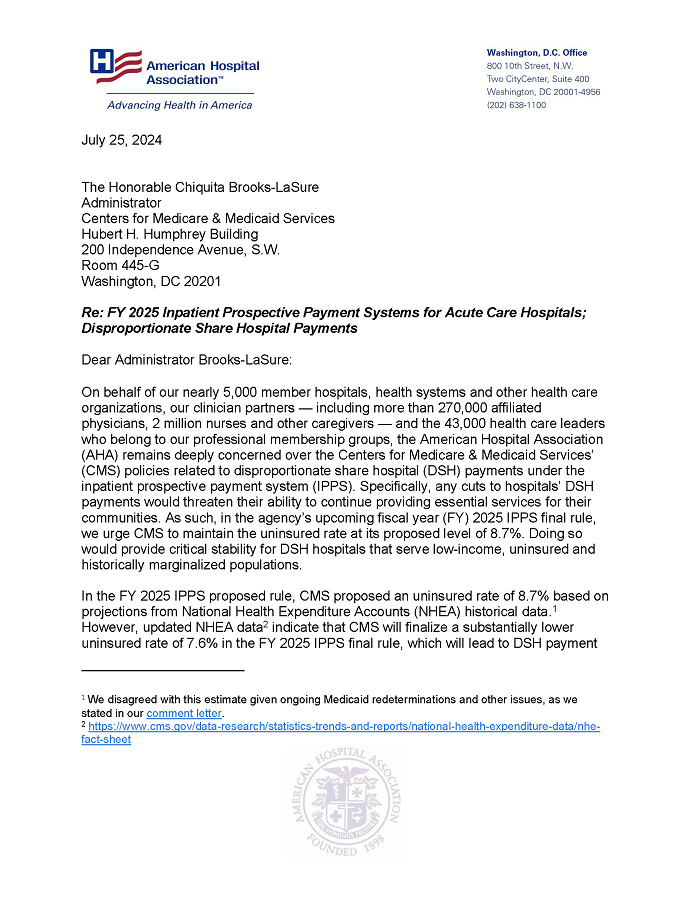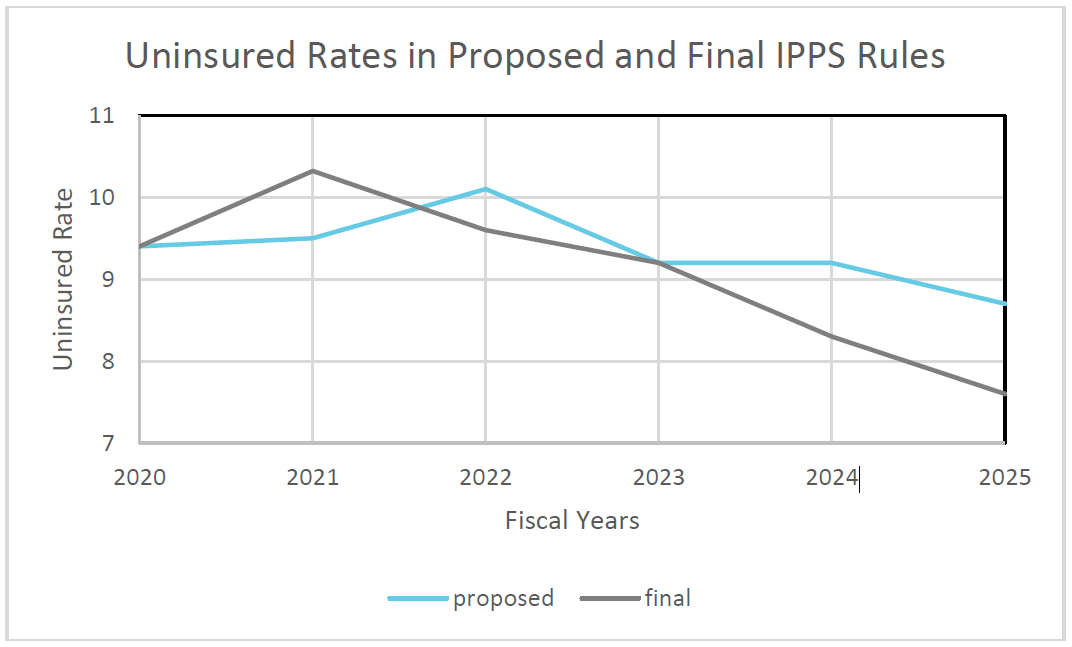

AHA Comments on Potential DSH Cuts in IPPS Final Rule for FY 2025
July 25, 2024
The Honorable Chiquita Brooks-LaSure
Administrator
Centers for Medicare & Medicaid Services
Hubert H. Humphrey Building
200 Independence Avenue, S.W.
Room 445-G
Washington, DC 20201
Re: FY 2025 Inpatient Prospective Payment Systems for Acute Care Hospitals; Disproportionate Share Hospital Payments
Dear Administrator Brooks-LaSure:
On behalf of our nearly 5,000 member hospitals, health systems and other health care organizations, our clinician partners — including more than 270,000 affiliated physicians, 2 million nurses and other caregivers — and the 43,000 health care leaders who belong to our professional membership groups, the American Hospital Association (AHA) remains deeply concerned over the Centers for Medicare & Medicaid Services’ (CMS) policies related to disproportionate share hospital (DSH) payments under the inpatient prospective payment system (IPPS). Specifically, any cuts to hospitals’ DSH payments would threaten their ability to continue providing essential services for their communities. As such, in the agency’s upcoming fiscal year (FY) 2025 IPPS final rule, we urge CMS to maintain the uninsured rate at its proposed level of 8.7%. Doing so would provide critical stability for DSH hospitals that serve low-income, uninsured and historically marginalized populations.
In the FY 2025 IPPS proposed rule, CMS proposed an uninsured rate of 8.7% based on projections from National Health Expenditure Accounts (NHEA) historical data.1 However, updated NHEA data2 indicate that CMS will finalize a substantially lower uninsured rate of 7.6% in the FY 2025 IPPS final rule, which will lead to DSH payment cuts for hospitals once again. Indeed, as shown below, over the past two years, the uninsured rate has fluctuated by at least a percentage point between the proposed and final rules, leading to uncertainty and instability in DSH payments for those hospitals that act as safety nets for low-income and uninsured populations. We note that data and projections that have previously worked when coverage levels were more stable may no longer be adequate during these times of turmoil.

In last year’s FY 2024 final rule, as a response to some of AHA’s concerns, the agency directed readers to NHEA projections and methodologies. It also directed readers to the Office of the Actuary’s (OACT) memorandum certifying the rate of uninsured. However, as we stated at the time, these documents are not transparent and do not provide sufficient detail. Specifically, there remains a significant lack of transparency over how the effects of the pandemic and the subsequent Medicaid redetermination process are added to NHEA’s model estimate. Indeed, the AHA since 2021 has expressed concerns over CMS’ lack of transparency regarding how it and the OACT are calculating DSH payments. The agency continues to withhold relevant information from the public, thereby depriving the AHA and others of the ability to comment on the basis for the agency’s decision. Without additional information regarding the OACT analysis, stakeholders can neither validate nor evaluate the complex calculations CMS has made in estimating the percent of uninsured and other factors used to determine DSH payments.
In a year with continued turbulent coverage losses, we urge CMS to carefully reconsider its reliance on current data sources and methodologies to estimate the rate of the uninsured. However, in the meantime, to provide stability to hospitals caring for patients, we urge CMS to finalize the uninsured rate as proposed – at 8.7% – for purposes of its FY 2025 DSH calculations.
Please contact me if you have questions or feel free to have a member of your team contact Shannon Wu, AHA’s director of policy, at swu@aha.org.
Sincerely,
/s/
Ashley B. Thompson
Senior Vice President
Public Policy Analysis and Development
- We disagreed with this estimate given ongoing Medicaid redeterminations and other issues, as we stated in our comment letter.
- https://www.cms.gov/data-research/statistics-trends-and-reports/national-health-expenditure-data/nhe-fact-sheet


